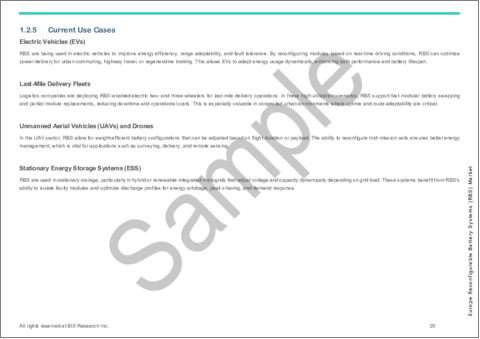|
|
市場調査レポート
商品コード
1756525
欧州のリコンフィギュラブルバッテリーシステム(RBS)市場:用途別、タイプ別、国別 - 分析と予測(2025年~2035年)Europe Reconfigurable Battery Systems (RBS) Market: Focus on Application, Type, and Country-Level Analysis - Analysis and Forecast, 2025-2035 |
||||||
カスタマイズ可能
|
|||||||
| 欧州のリコンフィギュラブルバッテリーシステム(RBS)市場:用途別、タイプ別、国別 - 分析と予測(2025年~2035年) |
|
出版日: 2025年06月26日
発行: BIS Research
ページ情報: 英文 69 Pages
納期: 1~5営業日
|
全表示
- 概要
- 図表
- 目次
欧州のリコンフィギュラブルバッテリーシステムの市場規模は、2024年に8億9,700万米ドルとなりました。
同市場は、2025年から2035年にかけて13.61%のCAGRで拡大し、2035年には35億6,840万米ドルに達すると予測されています。送電網の安定化、再生可能エネルギーの統合、電動モビリティといった業界全体で、柔軟でスケーラブルなエネルギー貯蔵に対する需要が高まっていることが、欧州のRBS業界を牽引しています。セル化学の開発、柔軟なシステム・トポロジー、欧州のスマートグリッド・プラットフォームとのスムーズな相互作用により、RBSの能力は高まっています。EUの野心的な気候目標や、各国のグリーンエネルギー補助金からHorizon Europeの研究助成金まで幅広い資金援助プログラムによって、普及が加速しています。電気事業者、OEM、技術系新興企業の協力により、次世代化学物質や二次電池の再利用におけるイノベーションが推進されています。リコンフィギュラブル・システムは、回復力、費用対効果、長期的競争力を保証する循環型、現地調達型バッテリーのバリューチェーンを推進する当局にとって、新たな機会をつかむ絶好のポジションにあります。
| 主要市場統計 | |
|---|---|
| 予測期間 | 2025年~2035年 |
| 2025年の評価 | 9億9,610万米ドル |
| 2035年予測 | 35億6,840万米ドル |
| CAGR | 13.61% |
市場イントロダクション
リコンフィギュラブルバッテリーシステム(RBS)市場は、変化するグリッド需要に対応するため、モジュール性、拡張性、管理強化を兼ね備えており、欧州のエネルギー転換において重要な役割を果たすようになっています。事業者は、パワーエレクトロニクスと高度なバッテリー管理システム(BMS)によって接続された、交換可能なセルまたはモジュール部品で構成されるリコンフィギュラブルバッテリーシステムによって、容量、性能、機能をリアルタイムで変更することができます。RBSは汎用性が高いため、商用ピークカット、遠隔マイクログリッド、大規模再生可能エネルギー統合、補助グリッドサービスなど、迅速な導入と適応が重要なさまざまな用途に最適です。
欧州のRBS市場は、積極的な脱炭素化目標、有利なEU政策枠組み、国内電池生産への投資増加により、急速に拡大しています。EV用二次電池や、リン酸鉄リチウム(LFP)やソリッドステート・プロトタイプのような新興化学物質の調査が費用対効果の高い選択肢を拡大する一方で、ネットゼロ産業法や重要原材料法は認可を迅速化し、現地生産を奨励し、持続可能な調達とリサイクルを保証しています。電力会社や独立系発電事業者が堅牢で将来性のあるストレージ・ソリューションを求める中、RBSサービスは、予知保全や最適な発送電のために、デジタル・プラットフォームや再生可能エネルギー源との連携がますます強まっています。
将来的には、標準化イニシアチブ、国際プロジェクト、リースやenergy-as-a-serviceのような金融構造の変化によって、導入がさらに加速されるでしょう。脱炭素、高信頼性、循環型のエネルギー・エコシステムを促進するために、再構成可能なシステムは、2030年までにバッテリー・サプライ・チェーンの90%までを現地化するという欧州の目標達成を支援する絶好の位置にあります。
市場セグメンテーション
セグメンテーション1:用途別
- 電気自動車
- グリッド・ストレージ・システム
- その他
セグメンテーション2:タイプ別
- モジュール式バッテリーパック
- スマートバッテリー管理システム
- スワップ型バッテリーモジュール
- リコンフィギュラブルハイブリッドエネルギー貯蔵
- その他
セグメンテーション3:地域別
- 欧州ドイツ、フランス、英国、その他
欧州のリコンフィギュラブルバッテリーシステム(RBS)市場動向と促進要因・課題
市場動向
- 再生可能エネルギー源(太陽光、風力)の導入が増加し、柔軟なモジュール式ストレージ・ソリューションへの需要が高まる
- バッテリー管理システム(BMS)とリアルタイム監視ソフトウェアの進歩により、機能性、安全性、再構成能力が向上
- 2030年までに電池の大半を欧州内で生産することを目指すEUの目標別、電池の国内生産の重視
主な促進要因
- 規制支援と資金援助:ネット・ゼロ産業法や重要原材料法のような政策は、認可を合理化し、現地調達/リサイクル割当を義務付ける
- 送電網の回復力とアンシラリーサービス:周波数調整、ピークカット、ブラックスタートサービスにおける機会により、モジュール式RBSは電力会社や独立系電力供給会社にとって費用対効果が高くなる
- 分散型およびオフグリッド・アプリケーション:従来の送電網を拡張することが現実的でない地方、遠隔地、マイクログリッドの設置に適したモジュール性
- 技術革新:相互互換性のあるモジュールやスケーラブルなアーキテクチャの研究開発により、カスタマイズや将来のアップグレードの障壁が低くなる
市場の課題
- 高額な初期投資:先進的なBMS、インフラ、研究開発に必要な多額の先行投資が、中小の参入企業の足かせとなる可能性がある
- 規制の断片化と標準の欠如:加盟国間で規則が異なり、統一された技術標準がないため、国境を越えた導入が進まない
- レガシー・ストレージとの競合:揚水発電や鉛蓄電池のような確立されたソリューションは、実績のある性能、低い資本コスト、既存のインフラから利益を得ている
- サプライチェーンとリサイクルのボトルネック:輸入リチウム、コバルト、ニッケルに依存し、リサイクル能力も未発達であるため、生産者は材料不足と価格変動にさらされる
- 許認可とグリッド接続の遅れ:長い認可プロセス、土地利用の制約、地元の反対運動により、プロジェクトのリードタイムが延びる可能性がある
製品/イノベーション戦略:このセグメントでは、電気自動車、グリッド・ストレージ・システムなど、用途に応じた多様なタイプのRBSについて調査しています。この市場では、モジュール式バッテリーパック、スマートバッテリー管理システム(BMS)、スワップ可能なバッテリーモジュール、再構成可能な水素エネルギー貯蔵など、様々なタイプで急速な技術革新が起きています。これらの進歩は、電気自動車(EV)、グリッド・ストレージ・システム、無停電電源装置(UPS)や家電製品などの他の分野など、複数の用途にわたってエネルギー貯蔵ソリューションの拡張性、効率性、適応性を高める上で極めて重要です。例えば、モジュラー・バッテリー・パックは、特定のエネルギー需要に応じて簡単に増設や減設ができるなど、柔軟性に大きな利点があり、エネルギー需要が変動するEVやグリッド・ストレージ・システムにとって理想的なソリューションとなっています。
成長/マーケティング戦略:欧州のリコンフィギュラブルバッテリーシステム(RBS)市場は、既存プレーヤーにも新規参入者にも大きな機会を提供しています。主な成長戦略には、M&A、戦略的提携、新製品投入、地理的拡大などがあります。企業は競争優位性を得るために、スマート・バッテリー管理システムや革新的な生産技術の開発を優先しています。二酸化炭素排出量を削減し、世界のエネルギー持続可能性目標に沿うことに重点を置くことで、市場の拡大がさらに加速しています。
競合戦略:当レポートでは、技術プロバイダーやインテグレーターなど、欧州のリコンフィギュラブルバッテリーシステム(RBS)市場の主要参入企業を紹介しています。戦略的パートナーシップ、協定、技術協力を網羅した詳細な競合情勢分析は、利害関係者が未開拓の収益機会を特定するのに役立ちます。この分析は、市場参入企業が技術革新、戦略的提携、持続可能性への注力を通じて自社の地位を高めることを支援します。
当レポートでは、欧州のリコンフィギュラブルバッテリーシステム(RBS)市場について調査し、市場の概要とともに、用途別、タイプ別、国別の動向、および市場に参入する企業のプロファイルなどを提供しています。
目次
エグゼクティブサマリー
第1章 市場:業界展望
- 動向:現状と将来への影響評価
- 電気自動車の販売増加
- バッテリー技術の進歩
- サプライチェーンの概要
- バリューチェーン分析
- 価格予測
- R&Dレビュー
- 特許出願動向(国別、企業別)
- 主な取り組み
- 調査機関と既存調査論文のレビュー
- 現在の市場シナリオ
- バッテリー市場概要
- 現在のバッテリー技術と課題
- 今後のバッテリー管理システム
- RBSの競争優位性と拡張性
- 他のバッテリー管理システムとの比較分析
- 現在のユースケース
- RBS回路設計の分析
- バッテリーシステムのリコンフィギュレーション管理原則
- 市場力学:概要
- 市場促進要因
- 市場抑制要因
- 市場機会
第2章 地域
- 地域のサマリー
- 欧州
- 地域概要
- 市場成長促進要因
- 市場成長抑制要因
- 用途
- 製品
- 欧州(国別)
第3章 市場-競合ベンチマーキングと企業プロファイル
- 地理的評価
- 戦略的取り組み
- VARTA AG
- sonnen
- その他
第4章 調査手法
List of Figures
- Figure 1: Europe Reconfigurable Battery Systems Market (by Scenario), $Billion, 2024, 2030, and 2035
- Figure 2: Reconfigurable Battery Systems Market (by Region), $Million, 2024, 2030, 2035
- Figure 3: Europe Reconfigurable Battery Systems Market (by Application), $Million, 2024, 2030, 2035
- Figure 4: Europe Reconfigurable Battery Systems Market (by Type), $Million, 2024, 2030, 2035
- Figure 5: Key Events
- Figure 6: Supply Chain
- Figure 7: Value Chain Analysis
- Figure 8: Patent Analysis (by Patent Office), January 2022-March 2025
- Figure 9: Patent Analysis (by Company), January 2022-March 2025
- Figure 10: Battery Energy Storage Market, GW, 2023-2030 (Net Zero Scenario)
- Figure 11: Battery Manufacturers in the Reconfigurable Battery Systems (RBS) Market
- Figure 12: End User in the Reconfigurable Battery Systems (RBS) Market
- Figure 13: Impact Analysis of Market Navigating Factors, 2024-2035
- Figure 14: Electric Car Registrations and Sales Share in %, Europe, 2020-2023
- Figure 15: Germany Reconfigurable Battery Systems (RBS) Market, $Million, 2024-2035
- Figure 16: Sales Share of Electric Vehicles (EVs), Germany, 2022 vs. 2023
- Figure 17: Battery Storage Capacities in GWh, Germany, 2022
- Figure 18: France Total Energy Production and Consumption in GWh, 2020-2023
- Figure 19: France Reconfigurable Battery Systems (RBS) Market, $Million, 2024-2035
- Figure 20: Europe Battery Electric Vehicle Volume, 2024
- Figure 21: U.K. Reconfigurable Battery Systems (RBS) Market, $Million, 2024-2035
- Figure 22: U.K. Sales and Forecasted Sales of Electric Vehicles in Million, 2025, 2030, and 2040
- Figure 23: Rest-of-Europe Reconfigurable Battery Systems (RBS) Market, $Million, 2024-2035
- Figure 24: Strategic Initiatives, January 2022-December 2024
- Figure 25: Data Triangulation
- Figure 26: Top-Down and Bottom-Up Approach
- Figure 27: Assumptions and Limitations
List of Tables
- Table 1: Market Snapshot
- Table 2: Opportunities across Regions
- Table 3: Competitive Landscape Snapshot
- Table 4: Trends in Reconfigurable Battery Systems (RBS) Market
- Table 5: Key Initiatives in the Reconfigurable Battery Systems (RBS) Market
- Table 6: Challenges in the Current Battery Technologies
- Table 7: Comparative Analysis of Reconfigurable Battery Systems (RBS) with Other Battery Management Systems
- Table 8: Reconfigurable Battery Systems (RBS) Market (by Region), $Million, 2024-2035
- Table 9: Europe Reconfigurable Battery Systems (RBS) Market (by Application), $Million, 2024-2035
- Table 10: Europe Reconfigurable Battery Systems (RBS) Market (by Type), $Million, 2024-2035
- Table 11: Germany Reconfigurable Battery Systems (RBS) Market (by Application), $Million, 2024-2035
- Table 12: Germany Reconfigurable Battery Systems (RBS) Market (by Type), $Million, 2024-2035
- Table 13: France Reconfigurable Battery Systems (RBS) Market (by Application), $Million, 2024-2035
- Table 14: France Reconfigurable Battery Systems (RBS) Market (by Type), $Million, 2024-2035
- Table 15: U.K. Reconfigurable Battery Systems (RBS) Market (by Application), $Million, 2024-2035
- Table 16: U.K. Reconfigurable Battery Systems (RBS) Market (by Type), $Million, 2024-2035
- Table 17: Rest-of-Europe Reconfigurable Battery Systems (RBS) Market (by Application), $Million, 2024-2035
- Table 18: Rest-of-Europe Reconfigurable Battery Systems (RBS) Market (by Type), $Million, 2024-2035
This report can be delivered in 2 working days.
Introduction to Europe Reconfigurable Battery Systems (RBS) Market
The Europe reconfigurable battery systems market was valued at $897.0 million in 2024 and is expected to reach $3,568.4 million by 2035, with a CAGR of 13.61% from 2025 to 2035. The increasing demand for flexible, scalable energy storage across industries like grid stabilisation, renewable energy integration, and electric mobility is driving the European RBS industry. RBS capabilities are growing thanks to developments in cell chemistry, flexible system topologies, and smooth interaction with Europe's smart-grid platforms. Deployment is being accelerated by ambitious EU climate targets and funding programs, which range from national green-energy subsidies to Horizon Europe research grants. Utility, OEM, and tech startup collaborations are propelling innovation in next-generation chemistries and second-life battery reuse. Reconfigurable systems are in a great position to seize new opportunities as authorities drive for a circular, locally sourced battery value chain, guaranteeing resilience, cost-effectiveness, and long-term competitiveness.
| KEY MARKET STATISTICS | |
|---|---|
| Forecast Period | 2025 - 2035 |
| 2025 Evaluation | $996.1 Million |
| 2035 Forecast | $3,568.4 Million |
| CAGR | 13.61% |
Market Introduction
The market for reconfigurable battery systems (RBS), which combine modularity, scalability, and enhanced management to meet changing grid demands, is becoming a crucial part of Europe's energy transformation. Operators can modify capacity, performance, and functionality in real time with reconfigurable battery systems, which are made up of interchangeable cell or module parts connected by power electronics and sophisticated battery management systems (BMS). Because of its versatility, RBS is perfect for a variety of applications where quick deployment and adaptation are crucial, such as commercial peak shaving, remote microgrids, large-scale renewable integration, and auxiliary grid services.
The European RBS market is expanding rapidly with to aggressive decarbonisation goals, advantageous EU policy frameworks, and rising investment in domestic battery production. While research into second-life EV batteries and emerging chemistries-like lithium iron phosphate (LFP) and solid-state prototypes-is expanding cost-effective options, the Net-Zero Industry Act and Critical Raw Materials Act are expediting approvals, encouraging local production, and guaranteeing sustainable sourcing and recycling. RBS services are becoming more and more linked with digital platforms and renewable energy sources for predictive maintenance and optimised dispatch as utilities and independent power producers look for robust, future-proof storage solutions.
In the future, adoption will be further accelerated by standardisation initiatives, international projects, and changing finance structures like leasing and energy-as-a-service. In order to facilitate a decarbonised, dependable, and circular energy ecosystem, reconfigurable systems are in a prime position to help Europe achieve its goal of localising up to 90% of its battery supply chain by 2030.
Market Segmentation
Segmentation 1: by Application
- Electric Vehicle
- Grid Storage Systems
- Others
Segmentation 2: by Type
- Modular Battery Pack
- Smart Battery Management System
- Swappable Battery Modules
- Reconfigurable Hybrid Energy Storage
- Others
Segmentation 3: by Region
- Europe: Germany, France, U.K., and Rest-of-Europe
Europe Reconfigurable Battery Systems (RBS) Market Trends, Drivers and Challenges
Market Trends
- Rising deployment of renewable energy sources (solar, wind) boosting demand for flexible, modular storage solutions
- Advances in battery management systems (BMS) and real-time monitoring software enhancing functionality, safety, and reconfiguration capability
- Emphasis on domestic battery production with EU targets aiming for the majority of batteries manufactured within Europe by 2030
Key Drivers
- Regulatory Support & Funding: Policies like the Net-Zero Industry Act and Critical Raw Materials Act streamline approvals and mandate local sourcing/recycling quotas
- Grid Resilience & Ancillary Services: Opportunities in frequency regulation, peak shaving, and black-start services making modular RBS cost-effective for utilities and independent power providers
- Decentralized & Off-Grid Applications: Modularity suited to rural, remote, and microgrid installations where extending the conventional grid is impractical
- Technological Innovation: R&D into cross-compatible modules and scalable architectures lowering barriers to customization and future upgrades
Market Challenges
- High Initial Investment: Significant upfront capital required for advanced BMS, infrastructure, and R&D can deter smaller players
- Regulatory Fragmentation & Lack of Standards: Divergent rules across member states and absence of unified technical standards slowing cross-border deployments
- Competition from Legacy Storage: Established solutions like pumped hydro and lead-acid batteries benefit from proven performance, lower capital costs, and existing infrastructure
- Supply Chain & Recycling Bottlenecks: Reliance on imported lithium, cobalt, and nickel-and under-developed recycling capacity-exposes producers to material shortages and price volatility
- Permitting & Grid Connection Delays: Lengthy approval processes, land-use constraints, and local opposition can extend project lead times
How can this report add value to an organization?
Product/Innovation Strategy: This segment explores the diverse types of RBS across applications, including electric vehicles, grid storage systems, and others. The market has been experiencing rapid innovation across various types, including modular battery packs, smart battery management systems (BMS), swappable battery modules, and reconfigurable hydrogen energy storage. These advancements are pivotal in enhancing energy storage solutions' scalability, efficiency, and adaptability across multiple applications such as electric vehicles (EVs), grid storage systems, and other sectors such as uninterruptible power supplies (UPS) and consumer electronics. The modular battery pack, for example, offers significant advantages in flexibility, allowing for easy expansion or reduction based on specific energy demands, making it an ideal solution for EVs and grid storage systems, where energy needs fluctuate.
Growth/Marketing Strategy: The Europe reconfigurable battery systems (RBS) market offers substantial opportunities for established players and new entrants. Key growth strategies include mergers and acquisitions, strategic collaborations, new product launches, and geographic expansion. Companies have prioritized developing smart battery management systems and innovative production technologies to gain a competitive advantage. The focus on reducing carbon footprints and aligning with global energy sustainability goals has been further accelerating market expansion.
Competitive Strategy: The report profiles major players in the Europe reconfigurable battery systems (RBS) market, including technology providers and integrators. A detailed competitive landscape analysis covering strategic partnerships, agreements, and technological collaborations is provided to help stakeholders identify untapped revenue opportunities. This analysis supports market participants in enhancing their position through innovation, strategic alliances, and a focus on sustainability.
Key Market Players and Competition Synopsis
The companies that are profiled in the Europe reconfigurable battery systems (RBS) market have been selected based on inputs gathered from primary experts, who have analyzed company coverage, product portfolio, and market penetration.
Some of the prominent names in the market are:
- VARTA AG
- sonnen
Table of Contents
Executive Summary
Scope and Definition
1 Market: Industry Outlook
- 1.1 Trends: Current and Future Impact Assessment
- 1.1.1 Rise in the Sales of Electric Vehicles
- 1.1.2 Advancements in Battery Technology
- 1.2 Supply Chain Overview
- 1.2.1 Value Chain Analysis
- 1.2.2 Pricing Forecast
- 1.3 R&D Review
- 1.3.1 Patent Filing Trend (by Country, by Company)
- 1.3.2 Key Initiatives
- 1.3.3 Research Institutions and Review of Existing Research Papers
- 1.4 Current Market Scenario
- 1.4.1 Battery Market Overview
- 1.4.1.1 Total Addressable Market
- 1.4.1.2 Stakeholder Analysis
- 1.4.1.2.1 Key Stakeholders
- 1.4.1.2.1.1 Battery Manufacturers
- 1.4.1.2.1.2 End Users
- 1.4.1.2.1 Key Stakeholders
- 1.4.2 Current Battery Technologies and Challenges
- 1.4.3 Upcoming Battery Management Systems
- 1.4.4 Competitive Advantages of RBS and Scalability
- 1.4.5 Comparative Analysis with Other Battery Management Systems
- 1.4.6 Current Use Cases
- 1.4.1 Battery Market Overview
- 1.5 Analysis of RBS Circuit Design
- 1.5.1 Management Principles of Battery System Reconfiguration
- 1.6 Market Dynamics: Overview
- 1.6.1 Market Drivers
- 1.6.1.1 Rising Demand for Renewable Energy Integration
- 1.6.1.2 Increase in Waste Management Initiatives
- 1.6.2 Market Restraints
- 1.6.2.1 Competition from Conventional Energy Storage
- 1.6.3 Market Opportunities
- 1.6.3.1 Remote and Off-Grid Energy Solutions
- 1.6.3.2 Government Support and Incentives
- 1.6.1 Market Drivers
2 Region
- 2.1 Regional Summary
- 2.2 Europe
- 2.2.1 Regional Overview
- 2.2.2 Driving Factors for Market Growth
- 2.2.3 Factors Challenging the Market
- 2.2.4 Application
- 2.2.5 Product
- 2.2.6 Europe (by Country)
- 2.2.6.1 Germany
- 2.2.6.1.1 EV Battery Supply and Demand Analysis
- 2.2.6.1.2 Grid Storage Capacity
- 2.2.6.1.3 Application
- 2.2.6.1.4 Product
- 2.2.6.2 France
- 2.2.6.2.1 EV Battery Supply and Demand Analysis
- 2.2.6.2.2 Grid Storage Capacity
- 2.2.6.2.3 Application
- 2.2.6.2.4 Product
- 2.2.6.3 U.K.
- 2.2.6.3.1 EV Battery Supply and Demand Analysis
- 2.2.6.3.2 Grid Storage Capacity
- 2.2.6.3.3 Application
- 2.2.6.3.4 Product
- 2.2.6.4 Rest-of-Europe
- 2.2.6.4.1 EV Battery Supply and Demand Analysis
- 2.2.6.4.2 Grid Storage Capacity
- 2.2.6.4.3 Application
- 2.2.6.4.4 Product
- 2.2.6.1 Germany
3 Markets - Competitive Benchmarking and Company Profiles
- 3.1 Geographic Assessment
- 3.2 Strategic Initiatives
- 3.2.1 VARTA AG
- 3.2.1.1 Overview
- 3.2.1.2 Top Products/Product Portfolio
- 3.2.1.3 Top Competitors
- 3.2.1.4 Target Customers/End Users
- 3.2.1.5 Key Personnel
- 3.2.1.6 Analyst View
- 3.2.2 sonnen
- 3.2.2.1 Overview
- 3.2.2.2 Top Products/Product Portfolio
- 3.2.2.3 Top Competitors
- 3.2.2.4 Target Customers/End Users
- 3.2.2.5 Key Personnel
- 3.2.2.6 Analyst View
- 3.2.1 VARTA AG
- 3.3 Other Key Players
4 Research Methodology
- 4.1 Data Sources
- 4.1.1 Primary Data Sources
- 4.1.2 Secondary Data Sources
- 4.1.3 Data Triangulation
- 4.2 Market Estimation and Forecast





